originally posted at https://canmom.tumblr.com/post/673320...
Hi friends, it’s a Thursday, which means I would like to show you some animations!
This week’s number is unfortunately inauspicious in political numerology, and what’s worse it will be a very long time until Animation Night 1312 by which point we’ll surely have run out of animated films, but since I have kind of already shown the major antifascist animated films I know about, let’s instead just use the number 8 to signify… a buncha gundams!
All together now… Moeagare GANDAMU~~~!
…ok, not actually that particular Gundam, but the song is such a banger that I had to post it.
Gundam is of course the oldest and mightiest mecha franchise, the jewel in the crown of the venerable anime studio Sunrise, and highly influential as the lead of the ‘real robot’ subgenre that took over from the prior ‘super robot’ shows. Gundam models, or Gunpla, are one of the core otaku industries. Gundam is sufficiently popular that they’ve even gone and built ‘life size’ gundam statues - soon to be four of them, in fact. We’ll talk about how this came to be in a little bit, but first let’s try to lay out the map a little bit.
If, like me, you’re curious to know what the fuss is about, you kind of hit a wall in that there is just so much Gundam, and it’s arranged so haphazardly that being a fan of Gundam has been likened to being a historian. Where do you begin? You will fairly soon discover that the Gundam title comprises several different, separate multipart stories, known as ‘timelines’. So some Gundam stories, such as Iron Blooded Orphans, are separate stories linked to the brand only by some similarities of design and shared staff. However, most of the material falls into one primary series, known as the Universal Century timeline. That’s the one that began in 1979 with Mobile Suit Gundam (機動戦士ガンダム Kidō Senshi Gandamu).
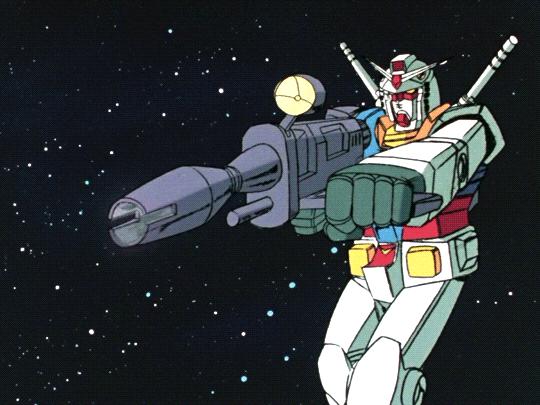
At the time Gundam arrived on the scene, mecha anime (anime about machines, primarily humanoid robots) was already well established as one of the major subgenres, closely linked to tokusatsu in terms of target demographics and sensibility.
Back then, mecha shows typically fell into a genre known as ‘super robot’. Here, the robots were essentially a kind of scifi spin on a superhero: a one of a kind machine with wondrous abilities. So let’s begin our history of Gundam a little earlier, with a history of robot anime in general.
Humanoid robots in manga originate in Tetsujin 28-gō (1956) [lit. Iron Man No. 28] by Mitsuteru Yokoyama, which you may recall cited by Otomo as a major influence on Akira; it featured a military robot built in the last days of the Japanese Empire repurposed by the son of its creator. Yokoyama drew on a number of his sources: primarily the manga of Osamu Tezuka (Animation Night 80), particularly Metropolis (whose adaptation by Rintaro we watched on Animation Night 53). But it also drew on his experiences living through the levelling of Kobe by American B-29 bombers, the 1931 film adaptation of Mary Shelly’s novel Frankenstein, and the rumours of secret Nazi weapons projects.
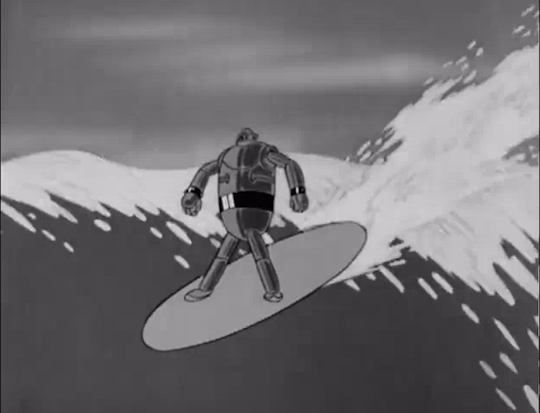
Much like Frankenstein’s monster, the robot in Tetsujin is not intrinsically good or evil; the manga’s protagonist, Shotaro Kaneda, manages to get to it before a group of gangsters and becomes a kind of boy detective figure insistent on using the robot for peace. The idea of sitting inside a humanoid robot had not yet become established, and Shotaro controlled it remotely. Design-wise, it’s much more a product of 50s movies than the distinctive Japanese robot aesthetic which would snowball later.
Alas, beyond that short summary, I have not on a brief look been able to find any scans of the manga, so I can’t tell you how it ends, or what thematic resolution they find. Regardless, Tetsujin was wildly popular, which had a variety of impacts - awkwardly, one of them being the coinage of the term ‘shotaro complex’ as a counterpart to ‘lolita complex’. It received an early anime adaptation in 1963, which like Speed Racer (Toku Tuesday 20) was redubbed in the first wave of anime localisations in America by Fred Ladd as Gigantor, removing the historical setting and tone down the violence; the same happened to the 1980 series. Subsequently, the short-lived Palm Studio produced a more faithful anime adaptation directed Yasuhiro Imagawa in 2004.

(^ Mazinger Z (1972) - here you can see how much simpler mech designs are in this period: spheres and cylinders, and rather inconsistent dark reflections. as we’ll see, this would be refined to an insane degree over the coming decades)
However, this was not yet a genre. Super robots truly became established in the 1972, when Go Nagai (of Devilman fame) published a manga called Mazinger Z. This introduced the idea of sitting inside the robot, and set the pattern for many plot elements. The protagonist’s father Professor Kabuto is a scientist whose boss Dr. Hell (no really) finds an army of robots under the Earth and decides to go for world domination; escaping, creates a special, advanced robot before being killed (and, trust Nagai, by “Baron Ashura, a half-man, half-woman”); his son must pilot the robot to fight Dr. Hell’s army.
As usual, Nagai had his finger on the psychic pulse, and his new storytelling formula became wildly popular. It very soon received an anime adaptation by Toei, and inspired a wide wave of imitators which copied most of the plot points. Like tokusatsu, the format gave them the ability to design a variety of weird looking enemies each week - just drawings instead of rubber suits.
Action animation at this point was still pretty stiff: the complex multi-layered camera movements of Ichiro Itano were still a long way to being invented. But it was a time of major change: the gritty gekiga style popular in manga of the time was spreading to anime with series like Tiger Mask and Ashita no Joe, and this is about the time when a young Yoshinori Kanada was starting his career. So the new genre of robot anime rode this wave, and proved a perfect fit for the Kanada’s emphases: striking poses, light flares, strong solid drawing varying framerate, playful physical comedy… and indeed, much of Kanada’s early work is on early shows like Getter Robo G.
Still, despite the new flashy innovations in animation techniques which were starting to define a distinctly anime style that could make the most of limited drawing counts, these super robot shows were largely telling the same sort of stories with the same primary drive: selling toy robots to children. And while you could totally read them as geopolitical, nationalist metaphors - the robot fighting off the monster of the week sublimating the resentment of Japan defending itself against the allies - they were on the surface level pretty black and white.
So it’s time to enter… Yoshiyuki Tomino!
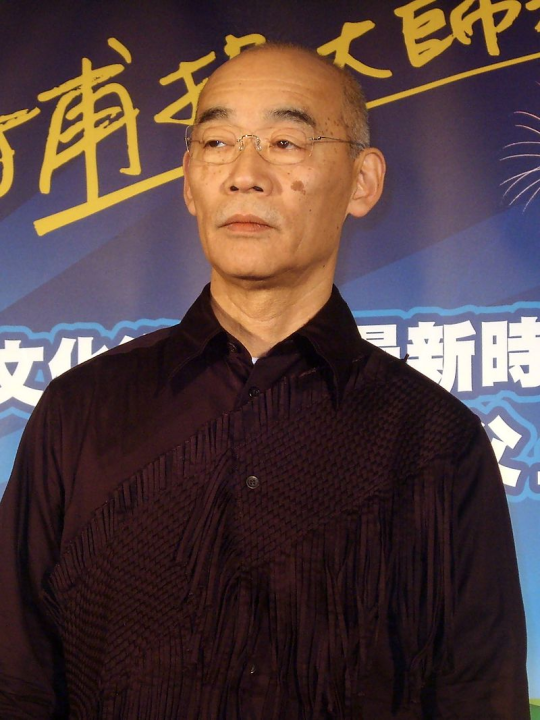
(he did not look like this in 1979!)
Well, OK, not so much enter. Yoshiyuki Tomino not only already on the scene by ‘79: he started work all the way back on Astro Boy in writing and storyboarding. Before long he started directing his own shows adapted a Tezuka manga, Blue Triton, as Triton of the Sea (1973), making an early stab at complicating the very black and white narrative of the original - and also setting up his reputation as ‘kill ‘em all’ Tomino by wiping out much of the cast by the ending.
He started working in the robot genre with Brave Raideen (1975) and Invincible Super Man Zambot 3 (1977-8), the latter apparently the point where the ‘kill ‘em all’ nickname stuck. But he was growing frustrated with the limitations of super robot shows. In Invincible Steel Man Daitarn 3 (1978), he started introducing more complex story elements from other genres, like spy stories and ironic pastiches. Evidently something was ripe for a change.
But the real break came in 1979, with Mobile Suit Gundam. The idea was to mix a robot show with hard science fiction space opera, and realism became a central drive - which is as has been hashed out endlessly since, an inherent contradiction since humanoid robots are far from practical military equipment. But the combination of meticulously observed machine animation and tragic war stories with cool humanoid robots proved explosively influential…
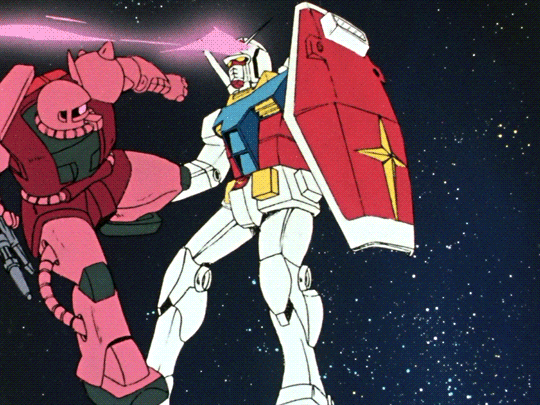
(^ this is an ambitious cut for the period, but notice how the Gundam (white mecha)’s legs change in size and proportion! they hadn’t quite got it at this point)
The title ‘Gundam’ is quite literally ‘gun dam’. It actually began as a portmanteau of ‘gun’ and ‘freedom’, with early iterations of the story imagining that the protagonists would belong to a ‘Freedom Base’, but Tomino changed it to ‘Gun Dam’ with the metaphor of a robot holding back enemies like a dam holding back water.
What was science fiction like at this time? Over in the English language, we could look at the Hugo Awards shortlist, where we’ll see Le Guin, Asimov, Clarke, Haldeman, Cherryh, Niven… or perhaps we could look at blogs like @70sscifiart. So a time of high concepts, space operas, and Vietnam metaphors… hard sci-fi was pretty central, and still considered a genuine speculative exercise rather than a nostalgic pantomime of a past genre.
And, of course, the US had only recently stopped sending people to the Moon, Japan was still riding an economic boom, there was still a Soviet Union and a Cold War and at least nominally still nominally a Space Race; the idea that humans would soon find their way to space en masse must have seemed much less of a romantic fantasy, but also the idea that once humans got up there they’d immediately stage an enormous scale war would have seemed all too plausible.
So Gundam is full of hard sci-fi concepts like helium-3 fusion and Lagrange point colonies. They go to great lengths to attempt to justify the central ‘humanoid robot’ premise as a reasonable military strategy with the convoluted concept of a ‘Minkowski particle’. But that’s details; what’s the narrative thrust?
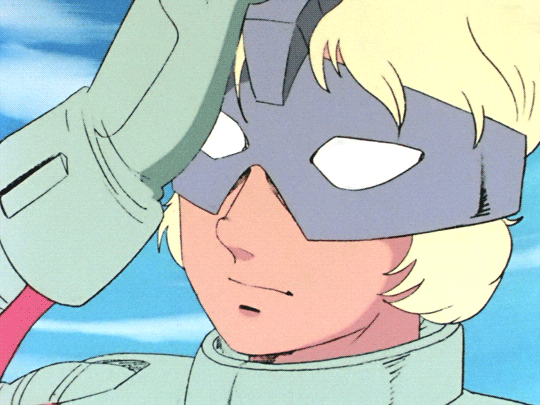
(^ this twink is Char, the major rival character/villain.)
The first Gundam doesn’t walk too far away from its super robot predecessors. A secessionist faction called Zeta, who are portrayed at this point entirely unsympathetically as fanatical and more than a little fashy, launch a war using their mecha which wipes out half of humanity. The protagonists belong to a polity called the Federation, which has developed a powerful new robot called (guess what) a Gundam. However, when they go to collect this robot, Zeta attacks. The protagonist, Amuro, gets in the robot and fends them off; in the process, he discovers he’s some kind of new evolution of humanity better adapted to space which becomes known as a Newtype, and thus becomes the regular Gundam pilot.
He’s opposed primarily by Char, a Zeta pilot who is modelled closely on the career of the Red Baron. Although flying for Zeta, Char has his own designs, and exploits the war to do away with the rival Zabi family who killed his peace-loving father. Naturally the series ends with Char facing Amuro in a duel - but Char realises at the last minute that he’s lost sight of his true goal (killing the Zabis) and flees to finish them off instead.
This story of rivals on either sides of a war with all attendant sexual tension (and bearing in mind Tomino’s Gundam is, I understand, far from kind to its girls) proved wildly popular. For Tomino, the principal theme is famously an anti-war one: despite all the cool robots they get to play with, going to war brings only tragedy to the cast.
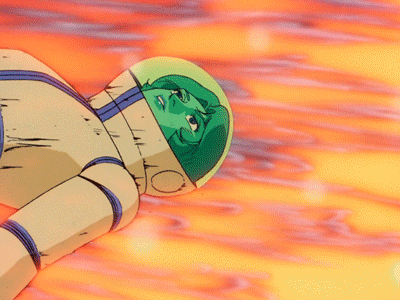
He pushed this even harder in his next project, Space Runaway Ideon (1980) about a group of humans in Andromeda running from a powerful military faction in ancient alien tanks, which despite first being cancelled on its original TV run, was able to finish its story in a final movie that’s known for mercilessly slaughtering its cast. (Which I would like to watch at some point so I can say something more about it than ‘haha… death…’)
Meanwhile, the Gundam juggernaut was getting seriously underway. The 1979 series was summarised in a trilogy of three movies (coming to a future Animation Night). The release became a notable event…
The first Gundam film, upon release on 22 February 1981, drew a large crowd of 15,000 people at its premiere, leading to concerns from police and media that it could lead to social unrest from a riotous crowd. The event is considered a turning point in the history of anime, referred to as “the day that anime changed” according to Asahi Shimbun newspaper.[20]
…although sadly I can’t report on a Gundam riot, fascinatingly as that would be.
Tomino set a certain tone for the mecha genre: a simultaneous fascination with military technology and deep antipathy, or at least ambivalence, towards its purpose. The psychological realism of his characters also developed, from the more iconic superhuman pilots of a super robot show to an attempt towards people who act irrationally, suffer war trauma, and can drive a story through their desires rather than stepping into the familiar roles of prosocial/antisocial. The mecha was increasingly a vulnerable body, able to be gruesomely destroyed; the dead pilot whose blood seeps out of the cockpit. (This was, therefore, a major step towards the territory of Neon Genesis Evangelion on the one hand, and the films of Mamoru Oshii such as Patlabor on another.)
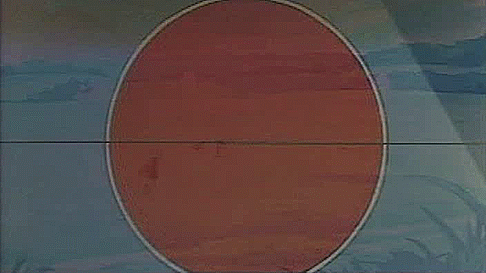
This political theme was not a natural thing either, but explicitly contested by animators. Shortly after Gundam, the industry was shaken by the Future War 198X controversy, related by Matteo Watzky here. In this event, a large portion of the industry signed open letters and protested the production of a near-future war film imagining a future World War III. Like Gundam, the film put a huge emphasis on realism, claiming to be an accurate projection of what such a war would look like. For many animators, this felt too much like profiting off militarism, and the unions were far from happy about its negative depiction of the Soviet Union. The result was a partial victory: the movie was made, but with an edited script ending in a rather clunky pacifistic ending in which a Star Wars-like program destroys all the missiles.
Over time, however, this political strand would diminish as anime increasingly became continuous with the notoriously apolitical otaku subculture. Gundam sits in an odd place: it is perhaps the epitome of otaku media as the source of highly profitable gunpla models, but despite that, its films and series insist on attempting to return to the same ‘anti-war’, more or less overtly political themes.
Of course, such territory is risky, and it won’t always be executed well. Gundam can end up as just characters with hilariously weird names launching into long but ultimately incoherent political rants. Over time, it attempts to add a more sympathetic dimension towards the aristocratic Zeon faction, with Char in particular swapping from antagonist to protagonist in the next series, and then going back round to antagonist again in the landmark film Char’s Counterattack (1988), a major accomplishment of animation which is unfortunately gated behind about a hundred episodes of TV anime to set the context. One day I’m going to figure out how to show it to you!
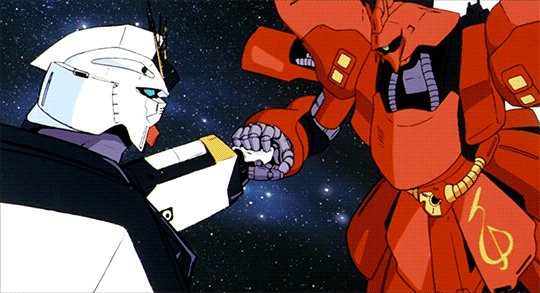
(^ note how much more detailed the mechanical designs are, and how much more consistently they are animated! the camera is also much more mobile, and the general sense of weight and motion is considerably more developed. Per sakugaboor, this cut was animated by Kouji Koizumi.)
Along the way, however, another strand of Gundam developed. While the main series emphasised big robot battles and dramatic rivalries playing out over decades, these side story OVAs tended to go for something a little smaller scale. War in the Pocket (1989), the one which I’ve seen, focuses on children in an O’Neill cylinder space colony who, running on militaristic fantasies, get pulled into the space war on different sides when some mecha crash into their habitat. Inevitably, they end up tragically dying in a futile skirmish.
08th MS Team comes much later, at the tail end of the 90s, when the realist movement in anime was well established. Its 90s stylings are certainly very clear in its character designs…
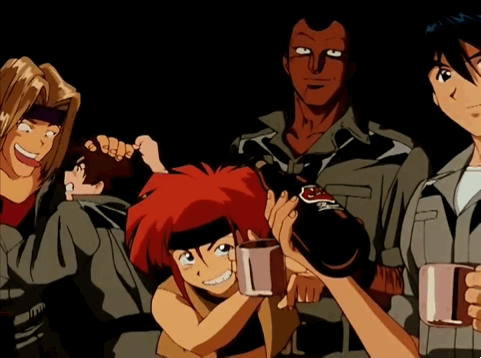
More so than the other Gundams, which tend more often to present superhuman pilots having flashy battles and high stakes duels in space, this iteration of Gundam attempts to be a gritty, down-to-earth war story. It pulls the battle down to Earth during the period of the first movie, with the fights consisting of tense jungle warfare emphasising lines of sight and logistics; its characters are seasoned and cynical soldiers rather than young prodigies.
The story naturally focuses on a connection forming between fighters on either side of the war - indeed, star-crossed lovers, Federation pilot Shiro newly assigned a command and talented Zeon pilot Aina. Shiro finds his loyalty in question when his rescue of Aina from a space wreck at the beginning of the show is discovered, and he is ordered to take his ragtag crew on a mission to destroy Aina. So it’s that juicy territory of personal vs political relationships, transcending inherited conflicts, etc. etc.
Animation-wise, 08th MS Team is also exceptional, coming at the tail end of the cel era and featuring many talented realist animators, such as Akihito Yamashita who would later work on Ghibli films - and even a young Yutaka Nakamura on his rise to the household-name (to anime fans) Sakuga Throne. The skill of these animators allows the robots to move with exceptional weight and presence, and interact believably with water and their environment, like in this iconic shot of a robot firing from behind a shield:
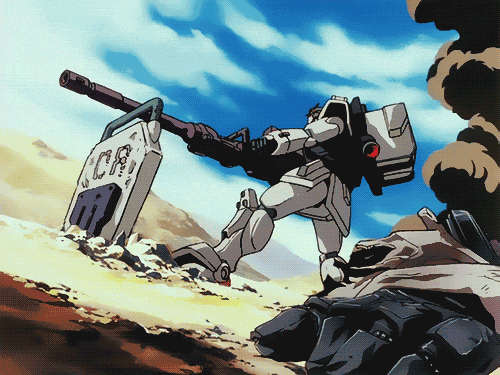
This makes fantastic use of an impact frame, slow-out, lighting on the environment, and especially secondary motion such that you really feel the force of this big gun. This is Sunrise at their absolute high point of traditional mecha animation, standing up to compete with the likes of Gainax’s Royal Space Force: The Wings of Honneamise (Animation Night 29).
The character animation is similarly strong, in that sharp 90s way; you can tell this is of an era with Eva and Macross Plus (Animation Night 64), but the characters are able to express a lot of subtle acting. For these reasons, and the strength of the story, 08th MS Team is widely recommended as a starting point for the Gundam-curious. So that’s where we’ll begin tonight - and if we still feel in a Gundam mood, at some point I’ll take us back to the trilogy of movies summarising the original 1979 Gundam, and then, well who knows?
(One strand I haven’t touched on much in this writeup is the actual mechanical design of the robots themselves - the substrate on which all of this is built. This is, alas, because I’m not particularly well informed about that subject! I hope I’ll be able to get to it in a future writeup, drawing on sites like zimmerit.moe. Surely someone has a compiled a history of Gundam design?)
So I’ve now watched 08th MS Team - and what a fascinating work it was!
I think the premise of a down-to-Earth, ‘Vietnam with robots’ Gundam was perhaps oversold a little; there is still more than enough goofy melodrama to go round, with the evil brother whose superweapon project drives the plot. Still, that’s all in service to the core thematic payload, which seems to be: what happens when a soldier takes the anti-war message to heart?
08th MS Team often feels like it’s being pulled in many different directions. This is in part because the original director, Takeyuki Kanda, died in a car crash after episode 5; after a delay of several months, the series resumed under Umanosuke Iida. So while early on the Zeon characters seem to be fairly one-note nazi analogues, it feels like later on they start attempting to give them a sympathetic dimension, while introducing a sociopathic commander to bear the sins of the Alliance forces. It’s attempting to depict a more complex picture of war. Does it succeed?
A key plot point - the main character, though under suspicion after his newfound pacifist ethos is discovered, being ordered to lead his unit on an attack on the enemy base - is actually rather brushed over; apparently this is properly expanded on in the compilation film, but it’s a little awkward. One minute he’s seen the sympathetic guerilla village destroyed in an entirely unnecessary confrontation with Zeon deserters, the next they’re being airdropped and the guerillas are not mentioned again until the final episode. And somewhat abruptly, the Zeon characters start getting considerably more screen time. It kind of feels like there’s an episode missing!
Still, all that said, lets get into the substance of it.
The first arc of the series sees Shiro growing into his role as a commander, despite his feelings for the enemy pilot Aina who he rescues at the outset. After he meets Aina a second time and the two are stranded together on a mountain, he seems to attempt to become a kind of Nausicaa or Ashitaka-like figure, intervening to attempt to prevent a conflict, and prevent needless deaths.
I am generally very fond of this type of character! However, this one feels a little more difficult to swallow - and on examination perhaps it’s doing something a little different. Miyazaki’s characters Nausicaa and Ashitaka are both touched by a kind of divine power: Nausicaa has a special connection to the forest, and Ashitaka, the power of the wounded forest god’s curse. They each become symbols, more than characters with flaws and desires. But they’re also both neutral figures. In the manga, Nausicaa sides early on with Kushana, and her hypocrisy is explicitly raised and calls her messianic status into doubt. They’re also more than willing to commit individual acts of violence: Ashitaka attacks the samurai, Nausicaa flips out and kills several Torumekian soldiers. This creates quite an interesting tension; they aren’t necessarily naive pacifists, however disgusted they are by the war they try to stop.
Shiro on the other hand is just a commissioned officer on his first command, and remains on the side of the Federation throughout most of the series, only deserting at the very end. His motivation is briefly revealed during his second meeting with Aina: the Zeon forces carried out a chemical attack on his hometown. But he seems pretty quick to forgive that, and before long he’s attempting a bizarre project to fight the war without killing anybody.
How does it go for him? We already mentioned the attack on the village, which is a spectacular failure in which most of the villagers are slaughtered and the three zeno pilots all die in their attempt to escape; Shiro’s other efforts include landing on a Zeon aeroplane and threatening them to stop firing and let his mechs land without blowing up the plane, and charging an enemy tank emplacement with his sword so that he can disable the commander’s tank without killing him. (Said enemy falling into something of the ‘honourable nazi commander’ trope.) These efforts tend to buy only a short-lived reprieve. The plane survives at least, but the honourable tank commander is quickly killed by the villain (Aina’s evil brother).
Aina gets the same bug; the final confrontation involves Aina attempting to hold everyone hostage with the superweapon to protect a refugee ship, only for her evil brother and the evil Federation commander to quickly break the attempted ceasefire. She persuades Shiro that her brother does in fact need to be killed, and the two board the superweapon to bring it down, but not before the superweapon destroys the Federation base regardless.
So in both cases, their loyalty to their own side, and willingness to pursue the designs of the baddies at the top, renders their efforts meaningless. Aina stands by while her forces commit massacres (one scene memorably raising a mild moral objection before going to sulk in her spaceship); Shiro continues to fight for the Federation despite no longer believing in the cause at all, seemingly only out of loyalty to his squad. He seems to believe that he can intervene to prevent just about every little skirmish - and yet the series underlines over and over that this is naive. But that’s like… no shit! Meanwhile, it rarely seems to show him actually negotiating: the Zeon commanders who he duels seem to just intuit his reluctance to kill and taunt him over it.
Yet if it’s meant as a critique of the Ashitaka archetype (this came only a couple of years after Princess Mononoke after all), it doesn’t really feel like this is clear. Shiro and Aina are still absolutely presented as sympathetic. More likely then, that this is a response to the same general feelings that Miyazaki was responding to…
The final episode sees a time skip to after the war; a whole load of children who have been tortured in evil experiments are abruptly introduced, who are raised offscreen by Aina and Shiro. The bulk of the episode sees one of the members of the old 08th MS Team searching for Shiro, alongside Kiki from the guerilla village. Although these children come rather out of left field, this episode’s tone really elevates it, I feel like - the general tense and melancholy atmosphere of a world covered by ruined war machines, and the depiction of the children in their enclave, both add a lot that felt like it was missing despite the excellent animation in the last couple of episodes. Ultimately, we find that Aina and Shiro truly have retreated from society, and now live in a picturesque log cabin overlooking the ocean somewhere on the largely abandoned Earth. Well, all right for some!
I am definitely put a little in mind of what I’ve heard about Metal Gear - yet Shiro hardly leads a breakaway faction of soldiers who no longer wish to serve either side of a war, but instead is just kind of a naive boy who everyone treats with bemusement (but still permit to pilot the mecha for some reason). Perhaps it would feel more satisfying with the inclusion of the scenes in the compilation film. The court-martial, and his change of heart where he admits he’s no longer willing to fire at the enemy, seems like it must be the core of the story; yet ironically for a series known for its long pontificating, Shiro hardly gets a chance to lay out his reasons for acting the way he does. A scene where he makes his case to the 08th MS Team who serve him that he’s not going to get them all killed for the sake of saving one of their enemies seems sorely needed; it would cement the idea that he’s their trusted leader even though he seems mad.
Because as it is, it seems like he went to war without ever reckoning with the fact that his enemies are people with their own motivations for fighting, and then is surprised to discover that one of them might be a girl he’s attracted to (after one meeting!), which just seems… like yeah ok he’s an idiot but come on lmao. So many of the characters seem curiously lacking in self-awareness.
The strongest episodes for me were perhaps earlier on, when we drill down on the characters of the squaddies like Michel and Eledore; it is a shame we didn’t have one of these for Karen. At these points, you do get a sense of people caught up in currents far larger than them; the interactions are well observed and funny, and I was fully expecting it to be setup for a tragic fate that would make me cry. Perhaps on my second watch I might appreciate more the way it goes…
And mind you, the animation was absolutely impeccable: the smoke, fire, and movement of robots and characters alike was delicious; the cels have that sharp but still slightly rough quality of the pre-digital era with the sharpness of a print from actual film, the background paintings are skilfully painted with the right degree of detail and a strong understanding of light and colour - it was a sakuga feast all round. I am deeply deeply impressed by Sunrise’s ability to give robots weight and presence.
Which made the 9-minute short Battle in Three Dimensions, animated in 2013, a depressing contrast. The douga was now clearly drawn on a computer with that characteristic mechanically even line width and far worse, 720p upscale blur; the backgrounds were now full of ugly digital brush textures and obvious CG models. It seemed like a very sad illustration of what been lost with the move to digital, ground that is now only barely being recovered. Which is a shame because if you look past the composite, the underlying drawings are clearly as strong as ever, with some impressively 3D-looking mech animation.
Anyway, despite my gripes about the narrative, I enjoyed that a great deal and I’m looking forward to the next time we explore a Gundam!
Comments